Organizational Behaviour: Culture, Motivation & Team Dynamics
VerifiedAdded on 2023/06/14
|15
|4005
|268
Report
AI Summary
This report analyzes organizational behavior within Morrison, a large retail brand, focusing on the influence of organizational culture, politics, and power on individual and team performance. It examines content and process theories of motivation, such as Maslow's hierarchy of needs, Herzberg's two-factor theory, Adam's equity theory, and Vroom's expectancy theory, to understand their impact on employee engagement. The report also distinguishes between effective and ineffective teams, highlighting key factors like conflict resolution, decision-making, and member contribution. Furthermore, it explores different philosophies of organizational behavior, aiming to provide insights for creating a dynamic and productive working environment. The analysis emphasizes the importance of positive organizational politics, fair power dynamics, and strategic motivation techniques for achieving long-term business goals.

UNIT 12.
ORGANIZATIONAL
BEHAVIOUR
ORGANIZATIONAL
BEHAVIOUR
Paraphrase This Document
Need a fresh take? Get an instant paraphrase of this document with our AI Paraphraser
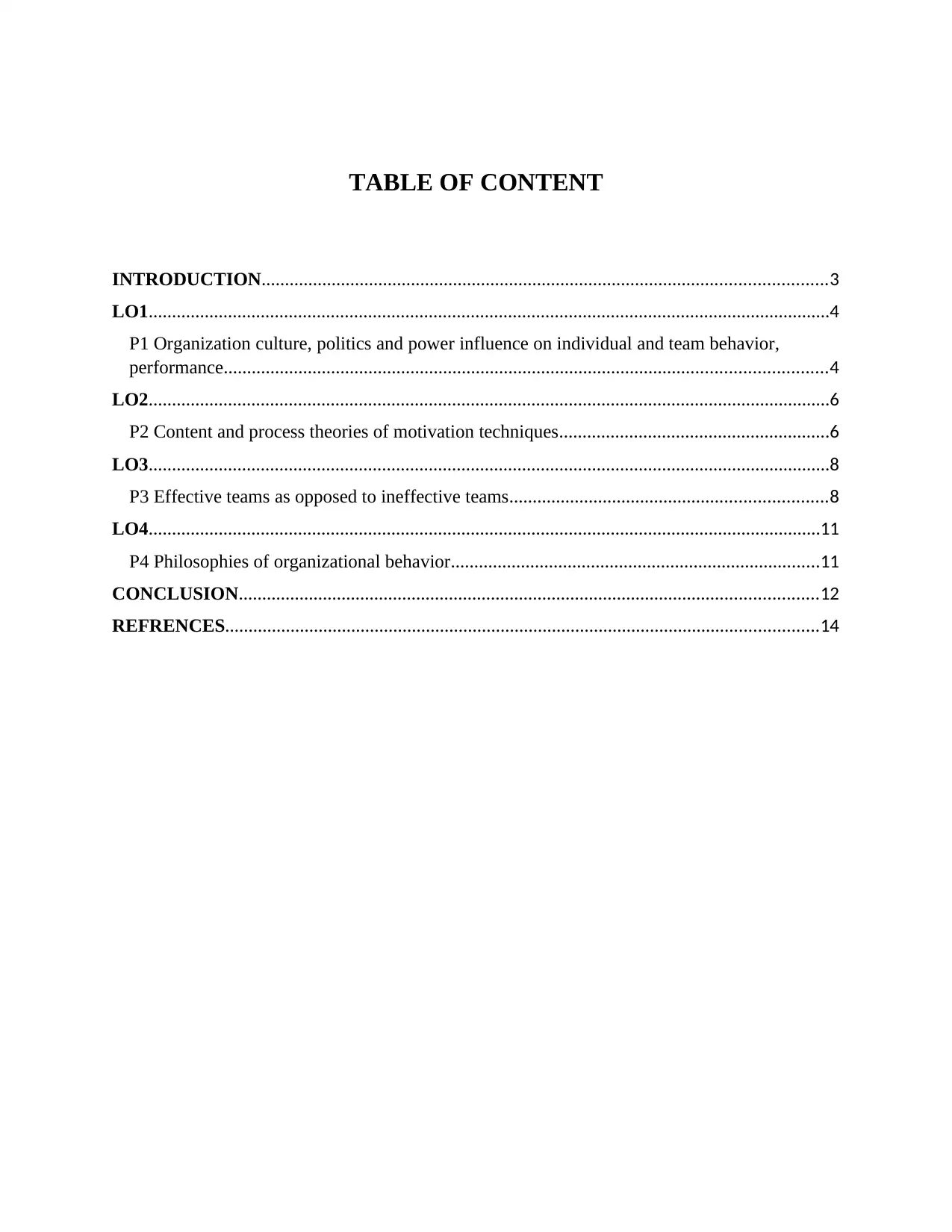
TABLE OF CONTENT
INTRODUCTION.........................................................................................................................3
LO1..................................................................................................................................................4
P1 Organization culture, politics and power influence on individual and team behavior,
performance.................................................................................................................................4
LO2..................................................................................................................................................6
P2 Content and process theories of motivation techniques..........................................................6
LO3..................................................................................................................................................8
P3 Effective teams as opposed to ineffective teams....................................................................8
LO4................................................................................................................................................11
P4 Philosophies of organizational behavior...............................................................................11
CONCLUSION............................................................................................................................12
REFRENCES...............................................................................................................................14
INTRODUCTION.........................................................................................................................3
LO1..................................................................................................................................................4
P1 Organization culture, politics and power influence on individual and team behavior,
performance.................................................................................................................................4
LO2..................................................................................................................................................6
P2 Content and process theories of motivation techniques..........................................................6
LO3..................................................................................................................................................8
P3 Effective teams as opposed to ineffective teams....................................................................8
LO4................................................................................................................................................11
P4 Philosophies of organizational behavior...............................................................................11
CONCLUSION............................................................................................................................12
REFRENCES...............................................................................................................................14
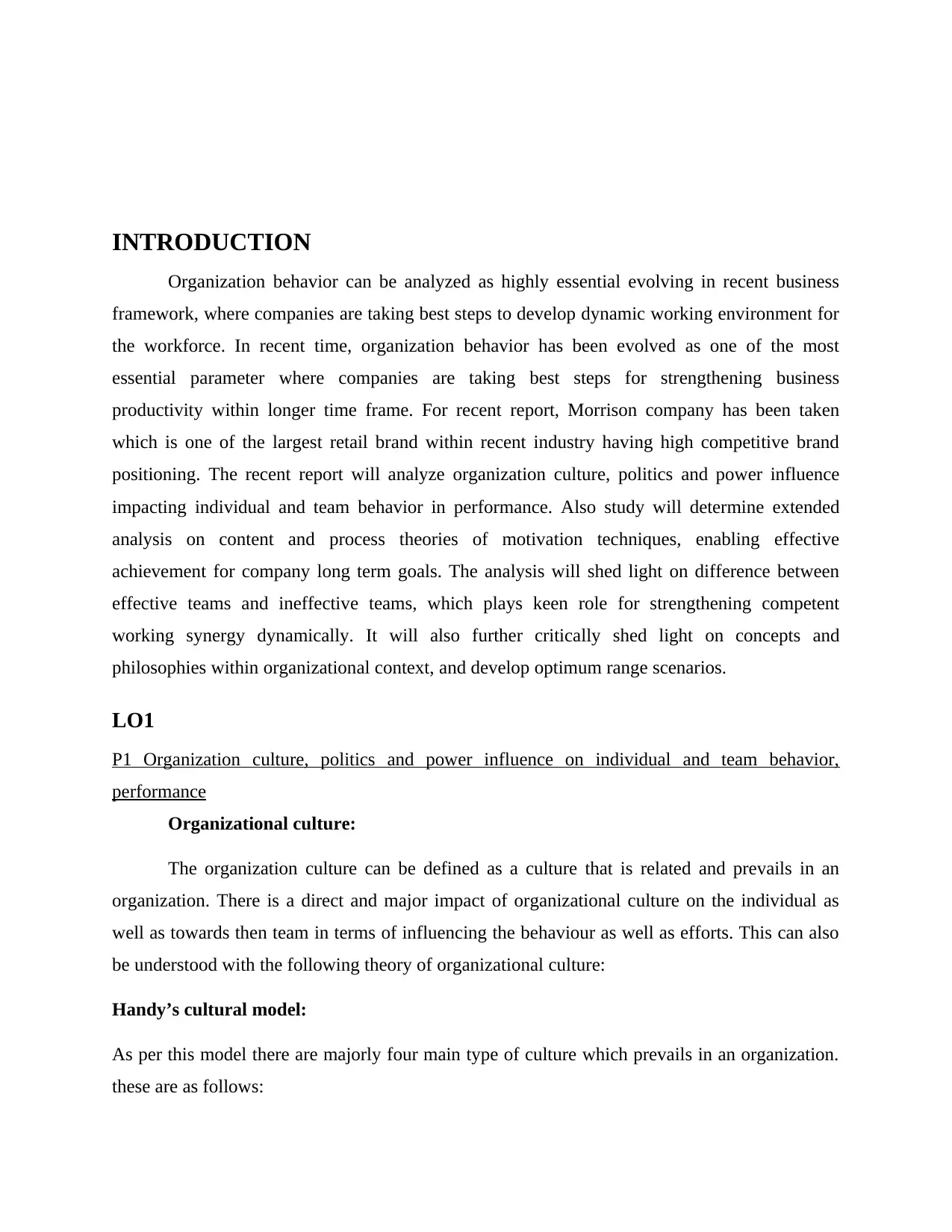
INTRODUCTION
Organization behavior can be analyzed as highly essential evolving in recent business
framework, where companies are taking best steps to develop dynamic working environment for
the workforce. In recent time, organization behavior has been evolved as one of the most
essential parameter where companies are taking best steps for strengthening business
productivity within longer time frame. For recent report, Morrison company has been taken
which is one of the largest retail brand within recent industry having high competitive brand
positioning. The recent report will analyze organization culture, politics and power influence
impacting individual and team behavior in performance. Also study will determine extended
analysis on content and process theories of motivation techniques, enabling effective
achievement for company long term goals. The analysis will shed light on difference between
effective teams and ineffective teams, which plays keen role for strengthening competent
working synergy dynamically. It will also further critically shed light on concepts and
philosophies within organizational context, and develop optimum range scenarios.
LO1
P1 Organization culture, politics and power influence on individual and team behavior,
performance
Organizational culture:
The organization culture can be defined as a culture that is related and prevails in an
organization. There is a direct and major impact of organizational culture on the individual as
well as towards then team in terms of influencing the behaviour as well as efforts. This can also
be understood with the following theory of organizational culture:
Handy’s cultural model:
As per this model there are majorly four main type of culture which prevails in an organization.
these are as follows:
Organization behavior can be analyzed as highly essential evolving in recent business
framework, where companies are taking best steps to develop dynamic working environment for
the workforce. In recent time, organization behavior has been evolved as one of the most
essential parameter where companies are taking best steps for strengthening business
productivity within longer time frame. For recent report, Morrison company has been taken
which is one of the largest retail brand within recent industry having high competitive brand
positioning. The recent report will analyze organization culture, politics and power influence
impacting individual and team behavior in performance. Also study will determine extended
analysis on content and process theories of motivation techniques, enabling effective
achievement for company long term goals. The analysis will shed light on difference between
effective teams and ineffective teams, which plays keen role for strengthening competent
working synergy dynamically. It will also further critically shed light on concepts and
philosophies within organizational context, and develop optimum range scenarios.
LO1
P1 Organization culture, politics and power influence on individual and team behavior,
performance
Organizational culture:
The organization culture can be defined as a culture that is related and prevails in an
organization. There is a direct and major impact of organizational culture on the individual as
well as towards then team in terms of influencing the behaviour as well as efforts. This can also
be understood with the following theory of organizational culture:
Handy’s cultural model:
As per this model there are majorly four main type of culture which prevails in an organization.
these are as follows:
⊘ This is a preview!⊘
Do you want full access?
Subscribe today to unlock all pages.

Trusted by 1+ million students worldwide
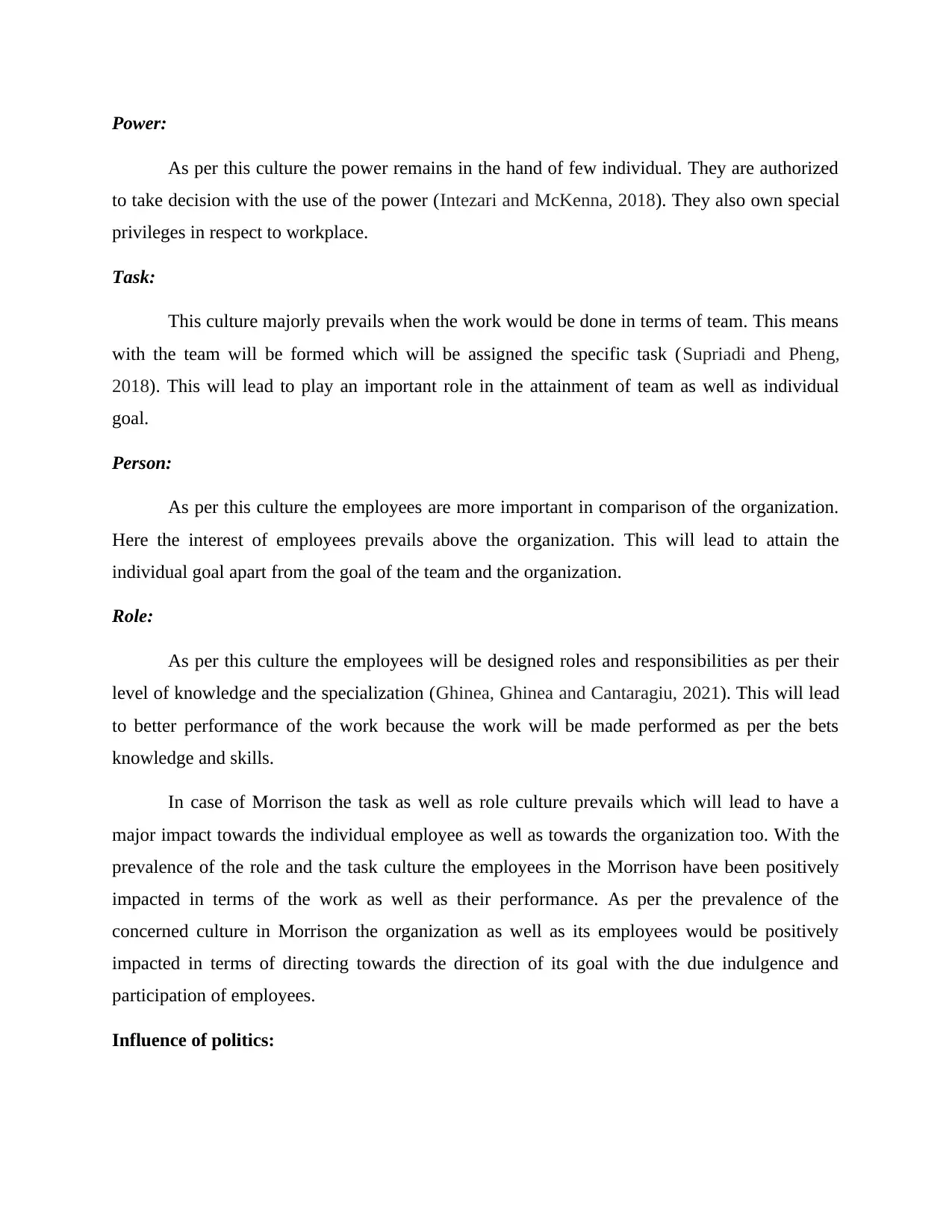
Power:
As per this culture the power remains in the hand of few individual. They are authorized
to take decision with the use of the power (Intezari and McKenna, 2018). They also own special
privileges in respect to workplace.
Task:
This culture majorly prevails when the work would be done in terms of team. This means
with the team will be formed which will be assigned the specific task (Supriadi and Pheng,
2018). This will lead to play an important role in the attainment of team as well as individual
goal.
Person:
As per this culture the employees are more important in comparison of the organization.
Here the interest of employees prevails above the organization. This will lead to attain the
individual goal apart from the goal of the team and the organization.
Role:
As per this culture the employees will be designed roles and responsibilities as per their
level of knowledge and the specialization (Ghinea, Ghinea and Cantaragiu, 2021). This will lead
to better performance of the work because the work will be made performed as per the bets
knowledge and skills.
In case of Morrison the task as well as role culture prevails which will lead to have a
major impact towards the individual employee as well as towards the organization too. With the
prevalence of the role and the task culture the employees in the Morrison have been positively
impacted in terms of the work as well as their performance. As per the prevalence of the
concerned culture in Morrison the organization as well as its employees would be positively
impacted in terms of directing towards the direction of its goal with the due indulgence and
participation of employees.
Influence of politics:
As per this culture the power remains in the hand of few individual. They are authorized
to take decision with the use of the power (Intezari and McKenna, 2018). They also own special
privileges in respect to workplace.
Task:
This culture majorly prevails when the work would be done in terms of team. This means
with the team will be formed which will be assigned the specific task (Supriadi and Pheng,
2018). This will lead to play an important role in the attainment of team as well as individual
goal.
Person:
As per this culture the employees are more important in comparison of the organization.
Here the interest of employees prevails above the organization. This will lead to attain the
individual goal apart from the goal of the team and the organization.
Role:
As per this culture the employees will be designed roles and responsibilities as per their
level of knowledge and the specialization (Ghinea, Ghinea and Cantaragiu, 2021). This will lead
to better performance of the work because the work will be made performed as per the bets
knowledge and skills.
In case of Morrison the task as well as role culture prevails which will lead to have a
major impact towards the individual employee as well as towards the organization too. With the
prevalence of the role and the task culture the employees in the Morrison have been positively
impacted in terms of the work as well as their performance. As per the prevalence of the
concerned culture in Morrison the organization as well as its employees would be positively
impacted in terms of directing towards the direction of its goal with the due indulgence and
participation of employees.
Influence of politics:
Paraphrase This Document
Need a fresh take? Get an instant paraphrase of this document with our AI Paraphraser
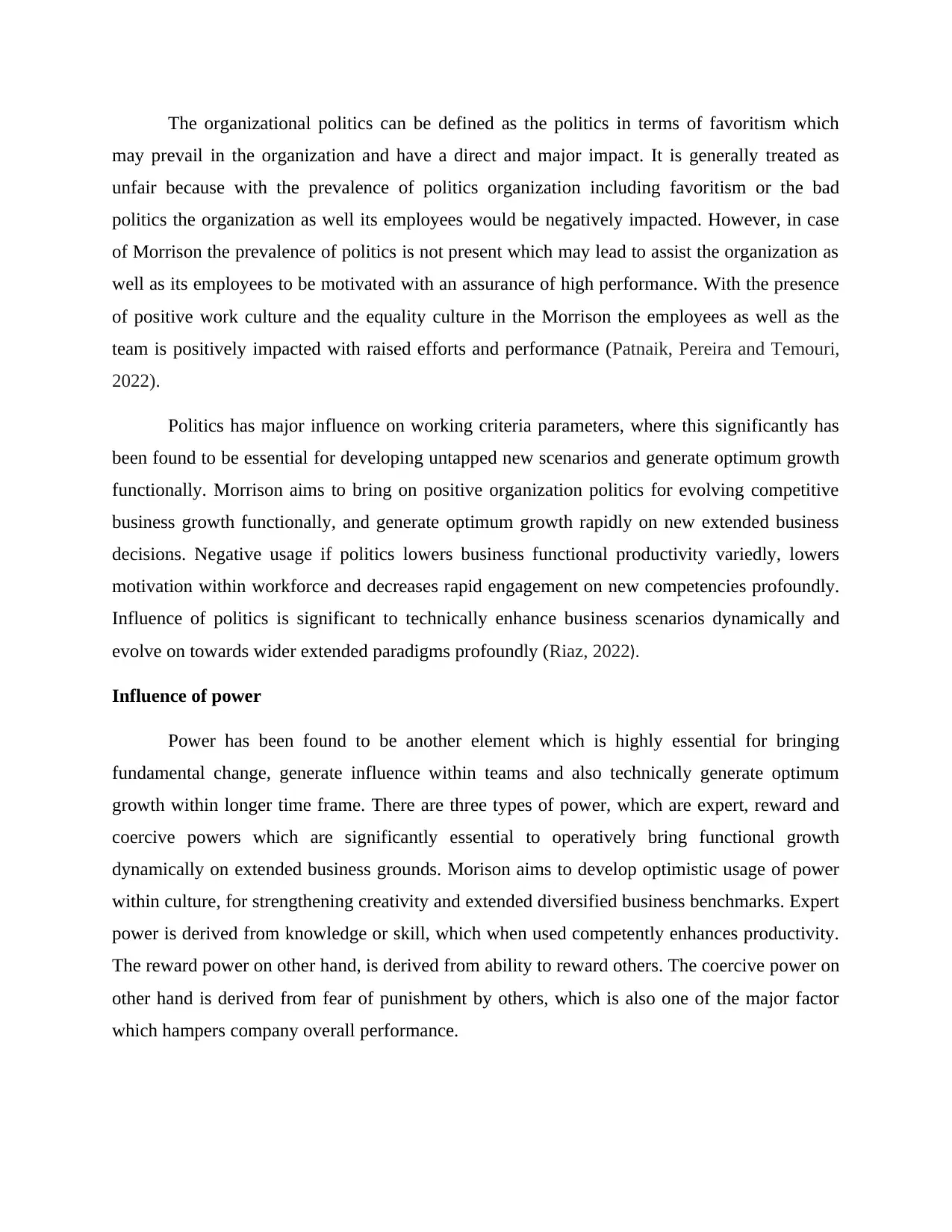
The organizational politics can be defined as the politics in terms of favoritism which
may prevail in the organization and have a direct and major impact. It is generally treated as
unfair because with the prevalence of politics organization including favoritism or the bad
politics the organization as well its employees would be negatively impacted. However, in case
of Morrison the prevalence of politics is not present which may lead to assist the organization as
well as its employees to be motivated with an assurance of high performance. With the presence
of positive work culture and the equality culture in the Morrison the employees as well as the
team is positively impacted with raised efforts and performance (Patnaik, Pereira and Temouri,
2022).
Politics has major influence on working criteria parameters, where this significantly has
been found to be essential for developing untapped new scenarios and generate optimum growth
functionally. Morrison aims to bring on positive organization politics for evolving competitive
business growth functionally, and generate optimum growth rapidly on new extended business
decisions. Negative usage if politics lowers business functional productivity variedly, lowers
motivation within workforce and decreases rapid engagement on new competencies profoundly.
Influence of politics is significant to technically enhance business scenarios dynamically and
evolve on towards wider extended paradigms profoundly (Riaz, 2022).
Influence of power
Power has been found to be another element which is highly essential for bringing
fundamental change, generate influence within teams and also technically generate optimum
growth within longer time frame. There are three types of power, which are expert, reward and
coercive powers which are significantly essential to operatively bring functional growth
dynamically on extended business grounds. Morison aims to develop optimistic usage of power
within culture, for strengthening creativity and extended diversified business benchmarks. Expert
power is derived from knowledge or skill, which when used competently enhances productivity.
The reward power on other hand, is derived from ability to reward others. The coercive power on
other hand is derived from fear of punishment by others, which is also one of the major factor
which hampers company overall performance.
may prevail in the organization and have a direct and major impact. It is generally treated as
unfair because with the prevalence of politics organization including favoritism or the bad
politics the organization as well its employees would be negatively impacted. However, in case
of Morrison the prevalence of politics is not present which may lead to assist the organization as
well as its employees to be motivated with an assurance of high performance. With the presence
of positive work culture and the equality culture in the Morrison the employees as well as the
team is positively impacted with raised efforts and performance (Patnaik, Pereira and Temouri,
2022).
Politics has major influence on working criteria parameters, where this significantly has
been found to be essential for developing untapped new scenarios and generate optimum growth
functionally. Morrison aims to bring on positive organization politics for evolving competitive
business growth functionally, and generate optimum growth rapidly on new extended business
decisions. Negative usage if politics lowers business functional productivity variedly, lowers
motivation within workforce and decreases rapid engagement on new competencies profoundly.
Influence of politics is significant to technically enhance business scenarios dynamically and
evolve on towards wider extended paradigms profoundly (Riaz, 2022).
Influence of power
Power has been found to be another element which is highly essential for bringing
fundamental change, generate influence within teams and also technically generate optimum
growth within longer time frame. There are three types of power, which are expert, reward and
coercive powers which are significantly essential to operatively bring functional growth
dynamically on extended business grounds. Morison aims to develop optimistic usage of power
within culture, for strengthening creativity and extended diversified business benchmarks. Expert
power is derived from knowledge or skill, which when used competently enhances productivity.
The reward power on other hand, is derived from ability to reward others. The coercive power on
other hand is derived from fear of punishment by others, which is also one of the major factor
which hampers company overall performance.

LO2
P2 Content and process theories of motivation techniques
There are various motivation theories, which can be analyzed for strengthening working
engagement proactively towards optimizing higher scale advancement and developing best
motivation strategically (Sasson and et;.al., 2022). Motivation techniques such as content
theories and process theories, collectively are essential to develop extended growth on business
platforms and primitively strengthen up working procedures. Content theories such as Maslow
hierarchy and Herzberg two factor theory are some of the major aspects, which synchronize best
motivation based on innovative parameters.
Maslow needs theory of motivation
Maslow needs theory of motivation are based on five categories such as human needs,
love and belonging needs, esteem needs and self-actualization needs for strengthened profound
motivation enrichment. The five factors of motivation are highly essential, to develop the best
working engagement and motivation among workforce for extensive growth innovatively. The
Maslow needs theory of motivation, is highly significant for competitive growth and also wider
motivated working scenarios diversification. Employees need to be given strategic working
growth platforms, as it also develops innovation in their working ideologies.
Herzberg theory of motivation
Herzberg theory of motivation, signifies that employee satisfaction has two dimensions such
as hygiene and motivation such as salary and supervision. It significantly develops optimum
extended motivation for company employees, functionally enhances vision within longer time
period. The two factors on which motivation is highly correlated are hygiene factors and
motivators, which are competently essential to develop expertise potentially (Singh and et.al,
2022).
Hygiene factors such as poor hygiene aspects decreases morale of employees for bringing
rise in new performance goals, which hampers business services. The engagement of
hygiene should be optimum, as it signifies new extended improvement which need to be
developed. Hygiene factors develops optimum expansion where company ideal focus on
improved hygiene facilities is essential.
P2 Content and process theories of motivation techniques
There are various motivation theories, which can be analyzed for strengthening working
engagement proactively towards optimizing higher scale advancement and developing best
motivation strategically (Sasson and et;.al., 2022). Motivation techniques such as content
theories and process theories, collectively are essential to develop extended growth on business
platforms and primitively strengthen up working procedures. Content theories such as Maslow
hierarchy and Herzberg two factor theory are some of the major aspects, which synchronize best
motivation based on innovative parameters.
Maslow needs theory of motivation
Maslow needs theory of motivation are based on five categories such as human needs,
love and belonging needs, esteem needs and self-actualization needs for strengthened profound
motivation enrichment. The five factors of motivation are highly essential, to develop the best
working engagement and motivation among workforce for extensive growth innovatively. The
Maslow needs theory of motivation, is highly significant for competitive growth and also wider
motivated working scenarios diversification. Employees need to be given strategic working
growth platforms, as it also develops innovation in their working ideologies.
Herzberg theory of motivation
Herzberg theory of motivation, signifies that employee satisfaction has two dimensions such
as hygiene and motivation such as salary and supervision. It significantly develops optimum
extended motivation for company employees, functionally enhances vision within longer time
period. The two factors on which motivation is highly correlated are hygiene factors and
motivators, which are competently essential to develop expertise potentially (Singh and et.al,
2022).
Hygiene factors such as poor hygiene aspects decreases morale of employees for bringing
rise in new performance goals, which hampers business services. The engagement of
hygiene should be optimum, as it signifies new extended improvement which need to be
developed. Hygiene factors develops optimum expansion where company ideal focus on
improved hygiene facilities is essential.
⊘ This is a preview!⊘
Do you want full access?
Subscribe today to unlock all pages.

Trusted by 1+ million students worldwide
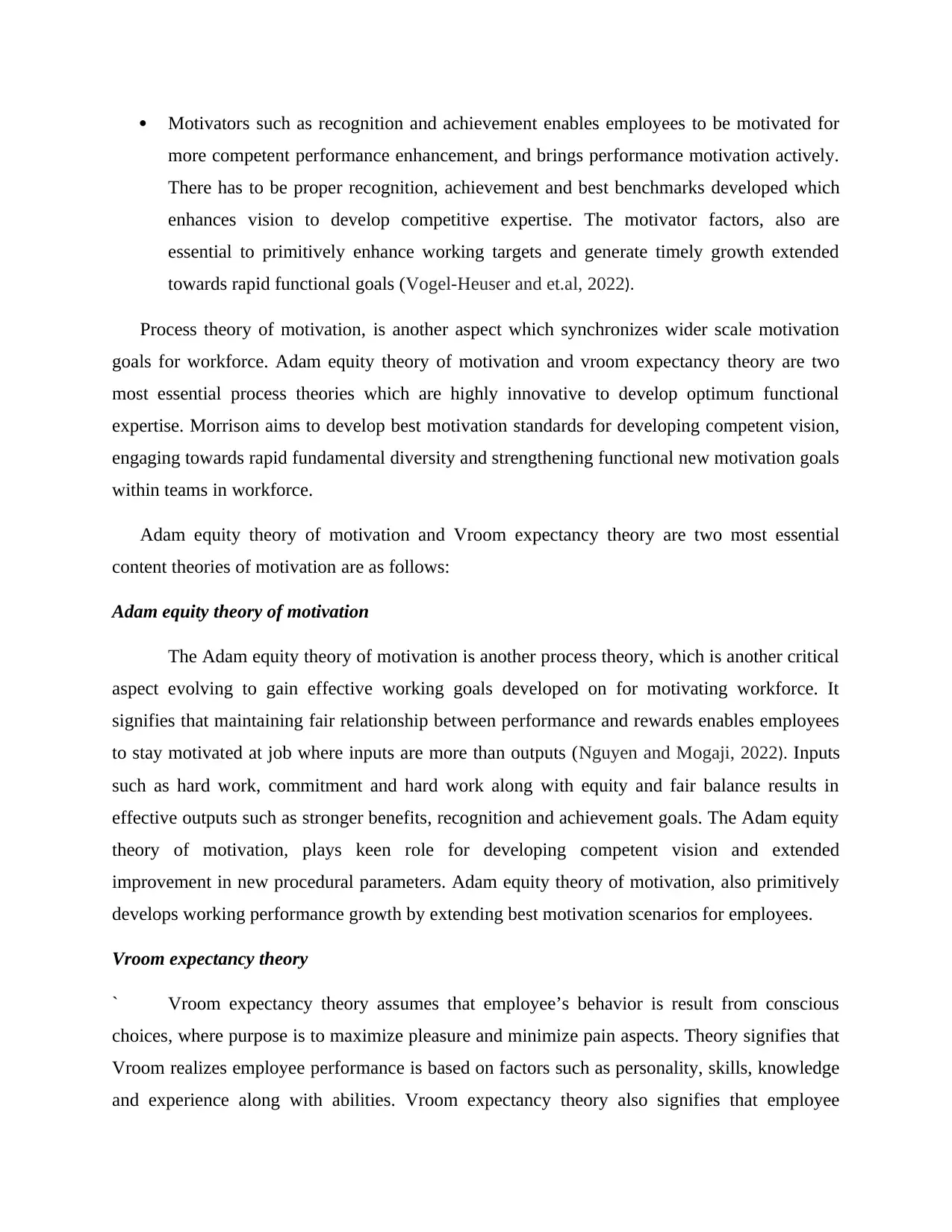
Motivators such as recognition and achievement enables employees to be motivated for
more competent performance enhancement, and brings performance motivation actively.
There has to be proper recognition, achievement and best benchmarks developed which
enhances vision to develop competitive expertise. The motivator factors, also are
essential to primitively enhance working targets and generate timely growth extended
towards rapid functional goals (Vogel-Heuser and et.al, 2022).
Process theory of motivation, is another aspect which synchronizes wider scale motivation
goals for workforce. Adam equity theory of motivation and vroom expectancy theory are two
most essential process theories which are highly innovative to develop optimum functional
expertise. Morrison aims to develop best motivation standards for developing competent vision,
engaging towards rapid fundamental diversity and strengthening functional new motivation goals
within teams in workforce.
Adam equity theory of motivation and Vroom expectancy theory are two most essential
content theories of motivation are as follows:
Adam equity theory of motivation
The Adam equity theory of motivation is another process theory, which is another critical
aspect evolving to gain effective working goals developed on for motivating workforce. It
signifies that maintaining fair relationship between performance and rewards enables employees
to stay motivated at job where inputs are more than outputs (Nguyen and Mogaji, 2022). Inputs
such as hard work, commitment and hard work along with equity and fair balance results in
effective outputs such as stronger benefits, recognition and achievement goals. The Adam equity
theory of motivation, plays keen role for developing competent vision and extended
improvement in new procedural parameters. Adam equity theory of motivation, also primitively
develops working performance growth by extending best motivation scenarios for employees.
Vroom expectancy theory
` Vroom expectancy theory assumes that employee’s behavior is result from conscious
choices, where purpose is to maximize pleasure and minimize pain aspects. Theory signifies that
Vroom realizes employee performance is based on factors such as personality, skills, knowledge
and experience along with abilities. Vroom expectancy theory also signifies that employee
more competent performance enhancement, and brings performance motivation actively.
There has to be proper recognition, achievement and best benchmarks developed which
enhances vision to develop competitive expertise. The motivator factors, also are
essential to primitively enhance working targets and generate timely growth extended
towards rapid functional goals (Vogel-Heuser and et.al, 2022).
Process theory of motivation, is another aspect which synchronizes wider scale motivation
goals for workforce. Adam equity theory of motivation and vroom expectancy theory are two
most essential process theories which are highly innovative to develop optimum functional
expertise. Morrison aims to develop best motivation standards for developing competent vision,
engaging towards rapid fundamental diversity and strengthening functional new motivation goals
within teams in workforce.
Adam equity theory of motivation and Vroom expectancy theory are two most essential
content theories of motivation are as follows:
Adam equity theory of motivation
The Adam equity theory of motivation is another process theory, which is another critical
aspect evolving to gain effective working goals developed on for motivating workforce. It
signifies that maintaining fair relationship between performance and rewards enables employees
to stay motivated at job where inputs are more than outputs (Nguyen and Mogaji, 2022). Inputs
such as hard work, commitment and hard work along with equity and fair balance results in
effective outputs such as stronger benefits, recognition and achievement goals. The Adam equity
theory of motivation, plays keen role for developing competent vision and extended
improvement in new procedural parameters. Adam equity theory of motivation, also primitively
develops working performance growth by extending best motivation scenarios for employees.
Vroom expectancy theory
` Vroom expectancy theory assumes that employee’s behavior is result from conscious
choices, where purpose is to maximize pleasure and minimize pain aspects. Theory signifies that
Vroom realizes employee performance is based on factors such as personality, skills, knowledge
and experience along with abilities. Vroom expectancy theory also signifies that employee
Paraphrase This Document
Need a fresh take? Get an instant paraphrase of this document with our AI Paraphraser
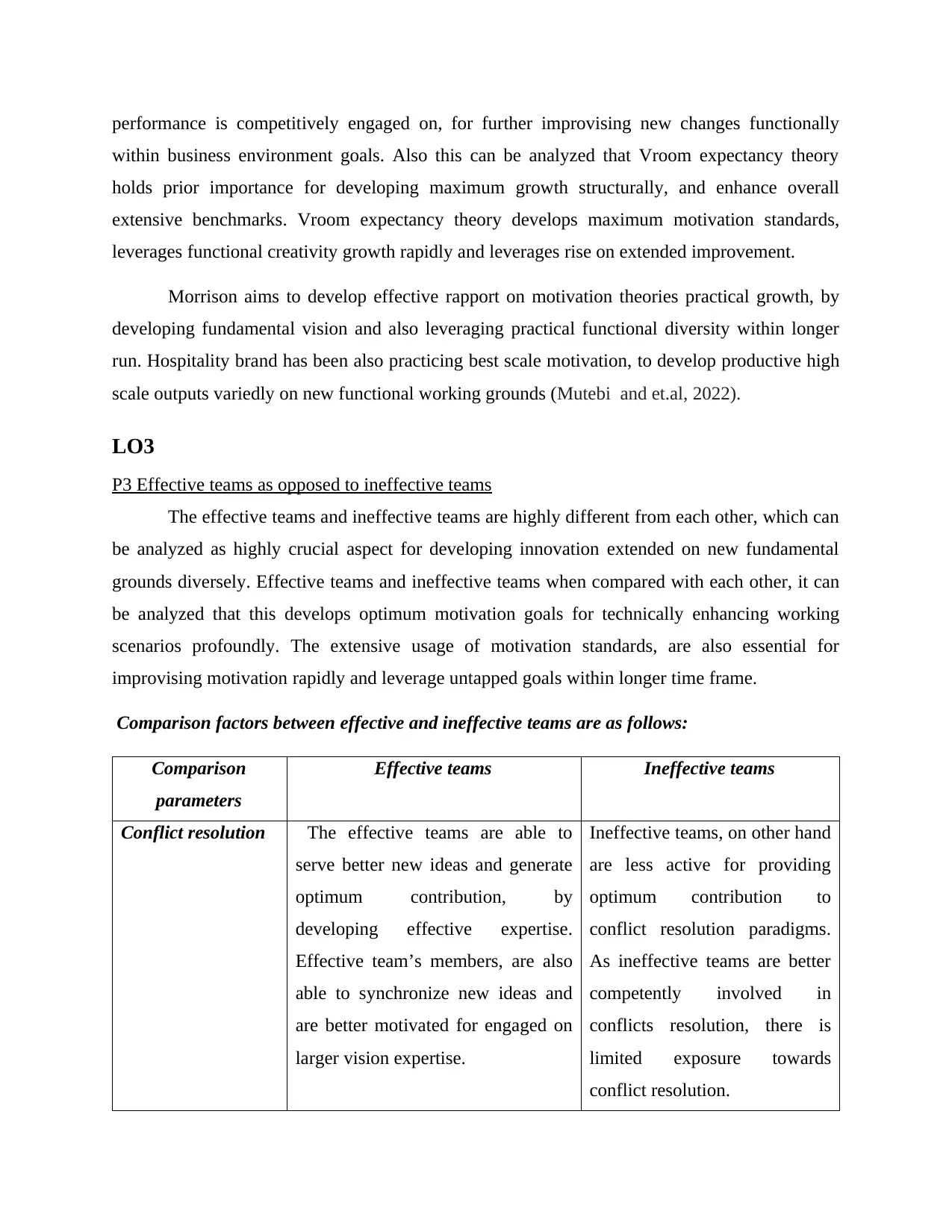
performance is competitively engaged on, for further improvising new changes functionally
within business environment goals. Also this can be analyzed that Vroom expectancy theory
holds prior importance for developing maximum growth structurally, and enhance overall
extensive benchmarks. Vroom expectancy theory develops maximum motivation standards,
leverages functional creativity growth rapidly and leverages rise on extended improvement.
Morrison aims to develop effective rapport on motivation theories practical growth, by
developing fundamental vision and also leveraging practical functional diversity within longer
run. Hospitality brand has been also practicing best scale motivation, to develop productive high
scale outputs variedly on new functional working grounds (Mutebi and et.al, 2022).
LO3
P3 Effective teams as opposed to ineffective teams
The effective teams and ineffective teams are highly different from each other, which can
be analyzed as highly crucial aspect for developing innovation extended on new fundamental
grounds diversely. Effective teams and ineffective teams when compared with each other, it can
be analyzed that this develops optimum motivation goals for technically enhancing working
scenarios profoundly. The extensive usage of motivation standards, are also essential for
improvising motivation rapidly and leverage untapped goals within longer time frame.
Comparison factors between effective and ineffective teams are as follows:
Comparison
parameters
Effective teams Ineffective teams
Conflict resolution The effective teams are able to
serve better new ideas and generate
optimum contribution, by
developing effective expertise.
Effective team’s members, are also
able to synchronize new ideas and
are better motivated for engaged on
larger vision expertise.
Ineffective teams, on other hand
are less active for providing
optimum contribution to
conflict resolution paradigms.
As ineffective teams are better
competently involved in
conflicts resolution, there is
limited exposure towards
conflict resolution.
within business environment goals. Also this can be analyzed that Vroom expectancy theory
holds prior importance for developing maximum growth structurally, and enhance overall
extensive benchmarks. Vroom expectancy theory develops maximum motivation standards,
leverages functional creativity growth rapidly and leverages rise on extended improvement.
Morrison aims to develop effective rapport on motivation theories practical growth, by
developing fundamental vision and also leveraging practical functional diversity within longer
run. Hospitality brand has been also practicing best scale motivation, to develop productive high
scale outputs variedly on new functional working grounds (Mutebi and et.al, 2022).
LO3
P3 Effective teams as opposed to ineffective teams
The effective teams and ineffective teams are highly different from each other, which can
be analyzed as highly crucial aspect for developing innovation extended on new fundamental
grounds diversely. Effective teams and ineffective teams when compared with each other, it can
be analyzed that this develops optimum motivation goals for technically enhancing working
scenarios profoundly. The extensive usage of motivation standards, are also essential for
improvising motivation rapidly and leverage untapped goals within longer time frame.
Comparison factors between effective and ineffective teams are as follows:
Comparison
parameters
Effective teams Ineffective teams
Conflict resolution The effective teams are able to
serve better new ideas and generate
optimum contribution, by
developing effective expertise.
Effective team’s members, are also
able to synchronize new ideas and
are better motivated for engaged on
larger vision expertise.
Ineffective teams, on other hand
are less active for providing
optimum contribution to
conflict resolution paradigms.
As ineffective teams are better
competently involved in
conflicts resolution, there is
limited exposure towards
conflict resolution.
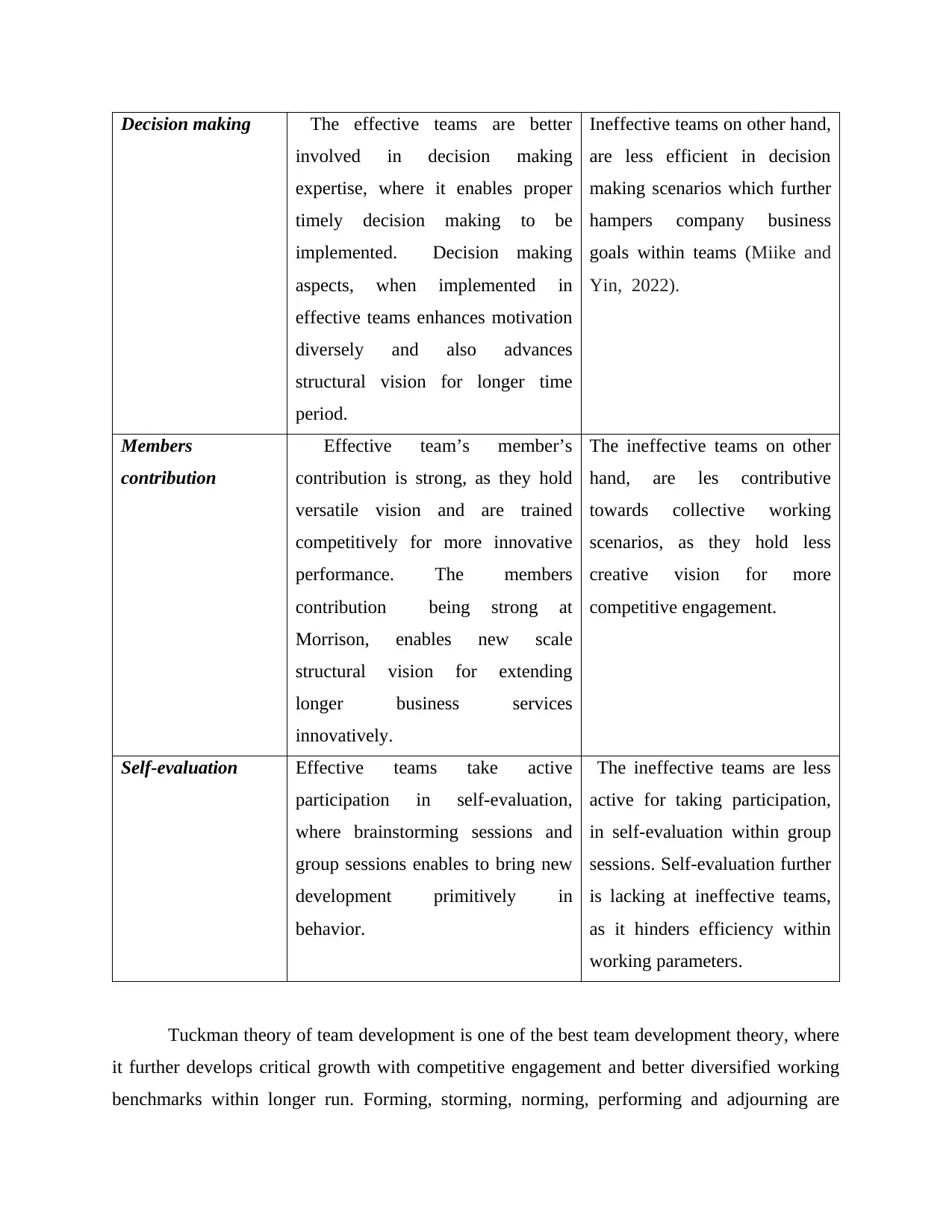
Decision making The effective teams are better
involved in decision making
expertise, where it enables proper
timely decision making to be
implemented. Decision making
aspects, when implemented in
effective teams enhances motivation
diversely and also advances
structural vision for longer time
period.
Ineffective teams on other hand,
are less efficient in decision
making scenarios which further
hampers company business
goals within teams (Miike and
Yin, 2022).
Members
contribution
Effective team’s member’s
contribution is strong, as they hold
versatile vision and are trained
competitively for more innovative
performance. The members
contribution being strong at
Morrison, enables new scale
structural vision for extending
longer business services
innovatively.
The ineffective teams on other
hand, are les contributive
towards collective working
scenarios, as they hold less
creative vision for more
competitive engagement.
Self-evaluation Effective teams take active
participation in self-evaluation,
where brainstorming sessions and
group sessions enables to bring new
development primitively in
behavior.
The ineffective teams are less
active for taking participation,
in self-evaluation within group
sessions. Self-evaluation further
is lacking at ineffective teams,
as it hinders efficiency within
working parameters.
Tuckman theory of team development is one of the best team development theory, where
it further develops critical growth with competitive engagement and better diversified working
benchmarks within longer run. Forming, storming, norming, performing and adjourning are
involved in decision making
expertise, where it enables proper
timely decision making to be
implemented. Decision making
aspects, when implemented in
effective teams enhances motivation
diversely and also advances
structural vision for longer time
period.
Ineffective teams on other hand,
are less efficient in decision
making scenarios which further
hampers company business
goals within teams (Miike and
Yin, 2022).
Members
contribution
Effective team’s member’s
contribution is strong, as they hold
versatile vision and are trained
competitively for more innovative
performance. The members
contribution being strong at
Morrison, enables new scale
structural vision for extending
longer business services
innovatively.
The ineffective teams on other
hand, are les contributive
towards collective working
scenarios, as they hold less
creative vision for more
competitive engagement.
Self-evaluation Effective teams take active
participation in self-evaluation,
where brainstorming sessions and
group sessions enables to bring new
development primitively in
behavior.
The ineffective teams are less
active for taking participation,
in self-evaluation within group
sessions. Self-evaluation further
is lacking at ineffective teams,
as it hinders efficiency within
working parameters.
Tuckman theory of team development is one of the best team development theory, where
it further develops critical growth with competitive engagement and better diversified working
benchmarks within longer run. Forming, storming, norming, performing and adjourning are
⊘ This is a preview!⊘
Do you want full access?
Subscribe today to unlock all pages.

Trusted by 1+ million students worldwide
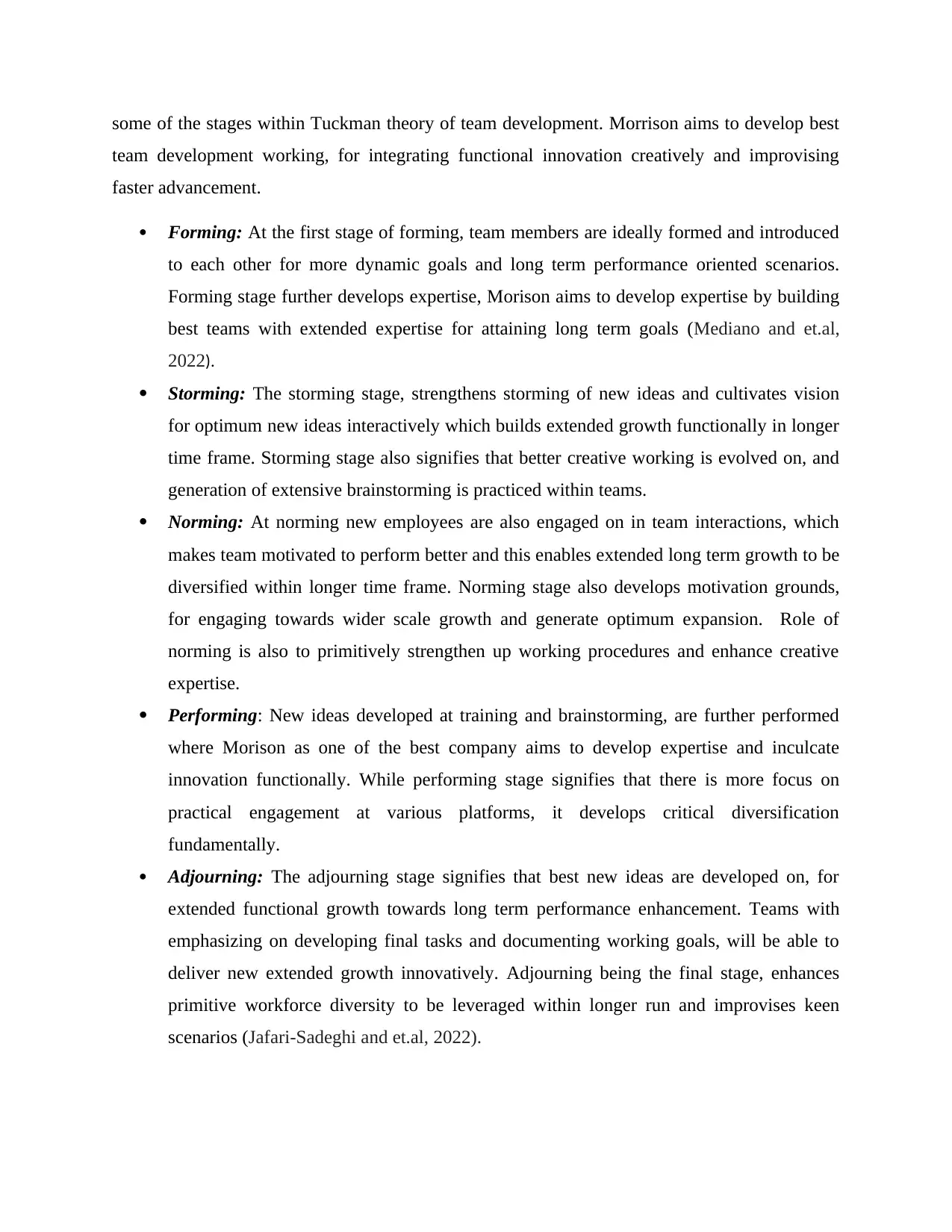
some of the stages within Tuckman theory of team development. Morrison aims to develop best
team development working, for integrating functional innovation creatively and improvising
faster advancement.
Forming: At the first stage of forming, team members are ideally formed and introduced
to each other for more dynamic goals and long term performance oriented scenarios.
Forming stage further develops expertise, Morison aims to develop expertise by building
best teams with extended expertise for attaining long term goals (Mediano and et.al,
2022).
Storming: The storming stage, strengthens storming of new ideas and cultivates vision
for optimum new ideas interactively which builds extended growth functionally in longer
time frame. Storming stage also signifies that better creative working is evolved on, and
generation of extensive brainstorming is practiced within teams.
Norming: At norming new employees are also engaged on in team interactions, which
makes team motivated to perform better and this enables extended long term growth to be
diversified within longer time frame. Norming stage also develops motivation grounds,
for engaging towards wider scale growth and generate optimum expansion. Role of
norming is also to primitively strengthen up working procedures and enhance creative
expertise.
Performing: New ideas developed at training and brainstorming, are further performed
where Morison as one of the best company aims to develop expertise and inculcate
innovation functionally. While performing stage signifies that there is more focus on
practical engagement at various platforms, it develops critical diversification
fundamentally.
Adjourning: The adjourning stage signifies that best new ideas are developed on, for
extended functional growth towards long term performance enhancement. Teams with
emphasizing on developing final tasks and documenting working goals, will be able to
deliver new extended growth innovatively. Adjourning being the final stage, enhances
primitive workforce diversity to be leveraged within longer run and improvises keen
scenarios (Jafari-Sadeghi and et.al, 2022).
team development working, for integrating functional innovation creatively and improvising
faster advancement.
Forming: At the first stage of forming, team members are ideally formed and introduced
to each other for more dynamic goals and long term performance oriented scenarios.
Forming stage further develops expertise, Morison aims to develop expertise by building
best teams with extended expertise for attaining long term goals (Mediano and et.al,
2022).
Storming: The storming stage, strengthens storming of new ideas and cultivates vision
for optimum new ideas interactively which builds extended growth functionally in longer
time frame. Storming stage also signifies that better creative working is evolved on, and
generation of extensive brainstorming is practiced within teams.
Norming: At norming new employees are also engaged on in team interactions, which
makes team motivated to perform better and this enables extended long term growth to be
diversified within longer time frame. Norming stage also develops motivation grounds,
for engaging towards wider scale growth and generate optimum expansion. Role of
norming is also to primitively strengthen up working procedures and enhance creative
expertise.
Performing: New ideas developed at training and brainstorming, are further performed
where Morison as one of the best company aims to develop expertise and inculcate
innovation functionally. While performing stage signifies that there is more focus on
practical engagement at various platforms, it develops critical diversification
fundamentally.
Adjourning: The adjourning stage signifies that best new ideas are developed on, for
extended functional growth towards long term performance enhancement. Teams with
emphasizing on developing final tasks and documenting working goals, will be able to
deliver new extended growth innovatively. Adjourning being the final stage, enhances
primitive workforce diversity to be leveraged within longer run and improvises keen
scenarios (Jafari-Sadeghi and et.al, 2022).
Paraphrase This Document
Need a fresh take? Get an instant paraphrase of this document with our AI Paraphraser
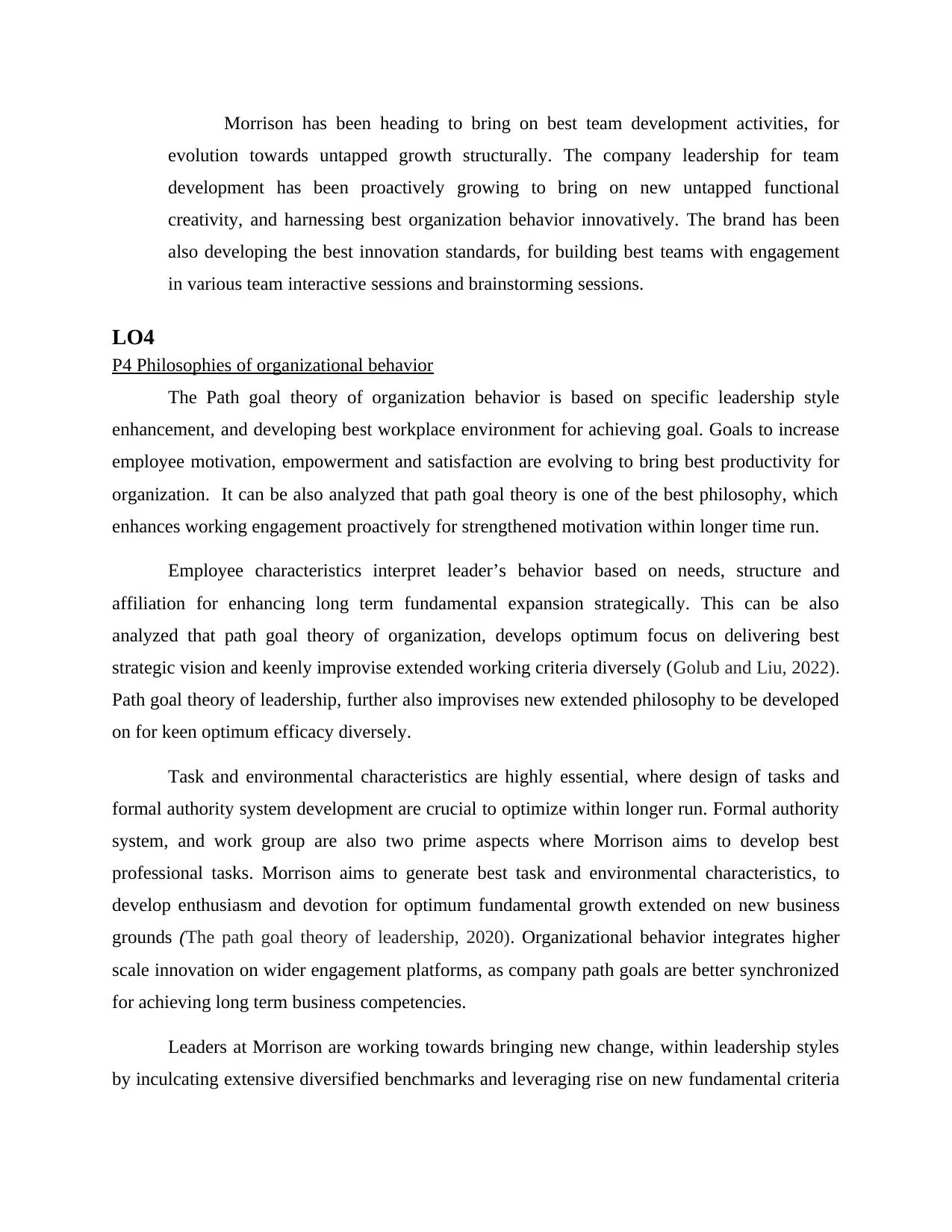
Morrison has been heading to bring on best team development activities, for
evolution towards untapped growth structurally. The company leadership for team
development has been proactively growing to bring on new untapped functional
creativity, and harnessing best organization behavior innovatively. The brand has been
also developing the best innovation standards, for building best teams with engagement
in various team interactive sessions and brainstorming sessions.
LO4
P4 Philosophies of organizational behavior
The Path goal theory of organization behavior is based on specific leadership style
enhancement, and developing best workplace environment for achieving goal. Goals to increase
employee motivation, empowerment and satisfaction are evolving to bring best productivity for
organization. It can be also analyzed that path goal theory is one of the best philosophy, which
enhances working engagement proactively for strengthened motivation within longer time run.
Employee characteristics interpret leader’s behavior based on needs, structure and
affiliation for enhancing long term fundamental expansion strategically. This can be also
analyzed that path goal theory of organization, develops optimum focus on delivering best
strategic vision and keenly improvise extended working criteria diversely (Golub and Liu, 2022).
Path goal theory of leadership, further also improvises new extended philosophy to be developed
on for keen optimum efficacy diversely.
Task and environmental characteristics are highly essential, where design of tasks and
formal authority system development are crucial to optimize within longer run. Formal authority
system, and work group are also two prime aspects where Morrison aims to develop best
professional tasks. Morrison aims to generate best task and environmental characteristics, to
develop enthusiasm and devotion for optimum fundamental growth extended on new business
grounds (The path goal theory of leadership, 2020). Organizational behavior integrates higher
scale innovation on wider engagement platforms, as company path goals are better synchronized
for achieving long term business competencies.
Leaders at Morrison are working towards bringing new change, within leadership styles
by inculcating extensive diversified benchmarks and leveraging rise on new fundamental criteria
evolution towards untapped growth structurally. The company leadership for team
development has been proactively growing to bring on new untapped functional
creativity, and harnessing best organization behavior innovatively. The brand has been
also developing the best innovation standards, for building best teams with engagement
in various team interactive sessions and brainstorming sessions.
LO4
P4 Philosophies of organizational behavior
The Path goal theory of organization behavior is based on specific leadership style
enhancement, and developing best workplace environment for achieving goal. Goals to increase
employee motivation, empowerment and satisfaction are evolving to bring best productivity for
organization. It can be also analyzed that path goal theory is one of the best philosophy, which
enhances working engagement proactively for strengthened motivation within longer time run.
Employee characteristics interpret leader’s behavior based on needs, structure and
affiliation for enhancing long term fundamental expansion strategically. This can be also
analyzed that path goal theory of organization, develops optimum focus on delivering best
strategic vision and keenly improvise extended working criteria diversely (Golub and Liu, 2022).
Path goal theory of leadership, further also improvises new extended philosophy to be developed
on for keen optimum efficacy diversely.
Task and environmental characteristics are highly essential, where design of tasks and
formal authority system development are crucial to optimize within longer run. Formal authority
system, and work group are also two prime aspects where Morrison aims to develop best
professional tasks. Morrison aims to generate best task and environmental characteristics, to
develop enthusiasm and devotion for optimum fundamental growth extended on new business
grounds (The path goal theory of leadership, 2020). Organizational behavior integrates higher
scale innovation on wider engagement platforms, as company path goals are better synchronized
for achieving long term business competencies.
Leaders at Morrison are working towards bringing new change, within leadership styles
by inculcating extensive diversified benchmarks and leveraging rise on new fundamental criteria
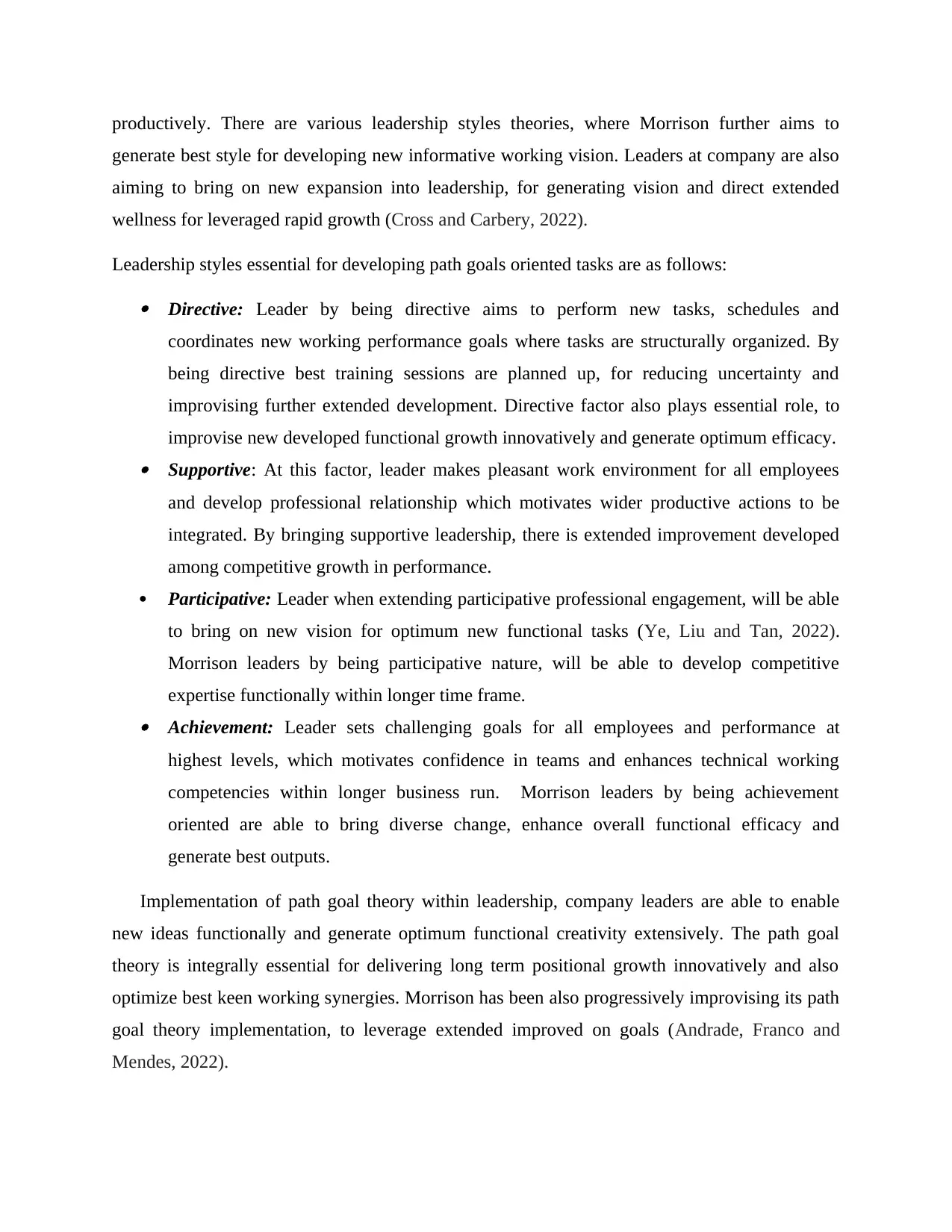
productively. There are various leadership styles theories, where Morrison further aims to
generate best style for developing new informative working vision. Leaders at company are also
aiming to bring on new expansion into leadership, for generating vision and direct extended
wellness for leveraged rapid growth (Cross and Carbery, 2022).
Leadership styles essential for developing path goals oriented tasks are as follows: Directive: Leader by being directive aims to perform new tasks, schedules and
coordinates new working performance goals where tasks are structurally organized. By
being directive best training sessions are planned up, for reducing uncertainty and
improvising further extended development. Directive factor also plays essential role, to
improvise new developed functional growth innovatively and generate optimum efficacy. Supportive: At this factor, leader makes pleasant work environment for all employees
and develop professional relationship which motivates wider productive actions to be
integrated. By bringing supportive leadership, there is extended improvement developed
among competitive growth in performance.
Participative: Leader when extending participative professional engagement, will be able
to bring on new vision for optimum new functional tasks (Ye, Liu and Tan, 2022).
Morrison leaders by being participative nature, will be able to develop competitive
expertise functionally within longer time frame. Achievement: Leader sets challenging goals for all employees and performance at
highest levels, which motivates confidence in teams and enhances technical working
competencies within longer business run. Morrison leaders by being achievement
oriented are able to bring diverse change, enhance overall functional efficacy and
generate best outputs.
Implementation of path goal theory within leadership, company leaders are able to enable
new ideas functionally and generate optimum functional creativity extensively. The path goal
theory is integrally essential for delivering long term positional growth innovatively and also
optimize best keen working synergies. Morrison has been also progressively improvising its path
goal theory implementation, to leverage extended improved on goals (Andrade, Franco and
Mendes, 2022).
generate best style for developing new informative working vision. Leaders at company are also
aiming to bring on new expansion into leadership, for generating vision and direct extended
wellness for leveraged rapid growth (Cross and Carbery, 2022).
Leadership styles essential for developing path goals oriented tasks are as follows: Directive: Leader by being directive aims to perform new tasks, schedules and
coordinates new working performance goals where tasks are structurally organized. By
being directive best training sessions are planned up, for reducing uncertainty and
improvising further extended development. Directive factor also plays essential role, to
improvise new developed functional growth innovatively and generate optimum efficacy. Supportive: At this factor, leader makes pleasant work environment for all employees
and develop professional relationship which motivates wider productive actions to be
integrated. By bringing supportive leadership, there is extended improvement developed
among competitive growth in performance.
Participative: Leader when extending participative professional engagement, will be able
to bring on new vision for optimum new functional tasks (Ye, Liu and Tan, 2022).
Morrison leaders by being participative nature, will be able to develop competitive
expertise functionally within longer time frame. Achievement: Leader sets challenging goals for all employees and performance at
highest levels, which motivates confidence in teams and enhances technical working
competencies within longer business run. Morrison leaders by being achievement
oriented are able to bring diverse change, enhance overall functional efficacy and
generate best outputs.
Implementation of path goal theory within leadership, company leaders are able to enable
new ideas functionally and generate optimum functional creativity extensively. The path goal
theory is integrally essential for delivering long term positional growth innovatively and also
optimize best keen working synergies. Morrison has been also progressively improvising its path
goal theory implementation, to leverage extended improved on goals (Andrade, Franco and
Mendes, 2022).
⊘ This is a preview!⊘
Do you want full access?
Subscribe today to unlock all pages.

Trusted by 1+ million students worldwide
1 out of 15
Related Documents
Your All-in-One AI-Powered Toolkit for Academic Success.
+13062052269
info@desklib.com
Available 24*7 on WhatsApp / Email
![[object Object]](/_next/static/media/star-bottom.7253800d.svg)
Unlock your academic potential
Copyright © 2020–2025 A2Z Services. All Rights Reserved. Developed and managed by ZUCOL.





